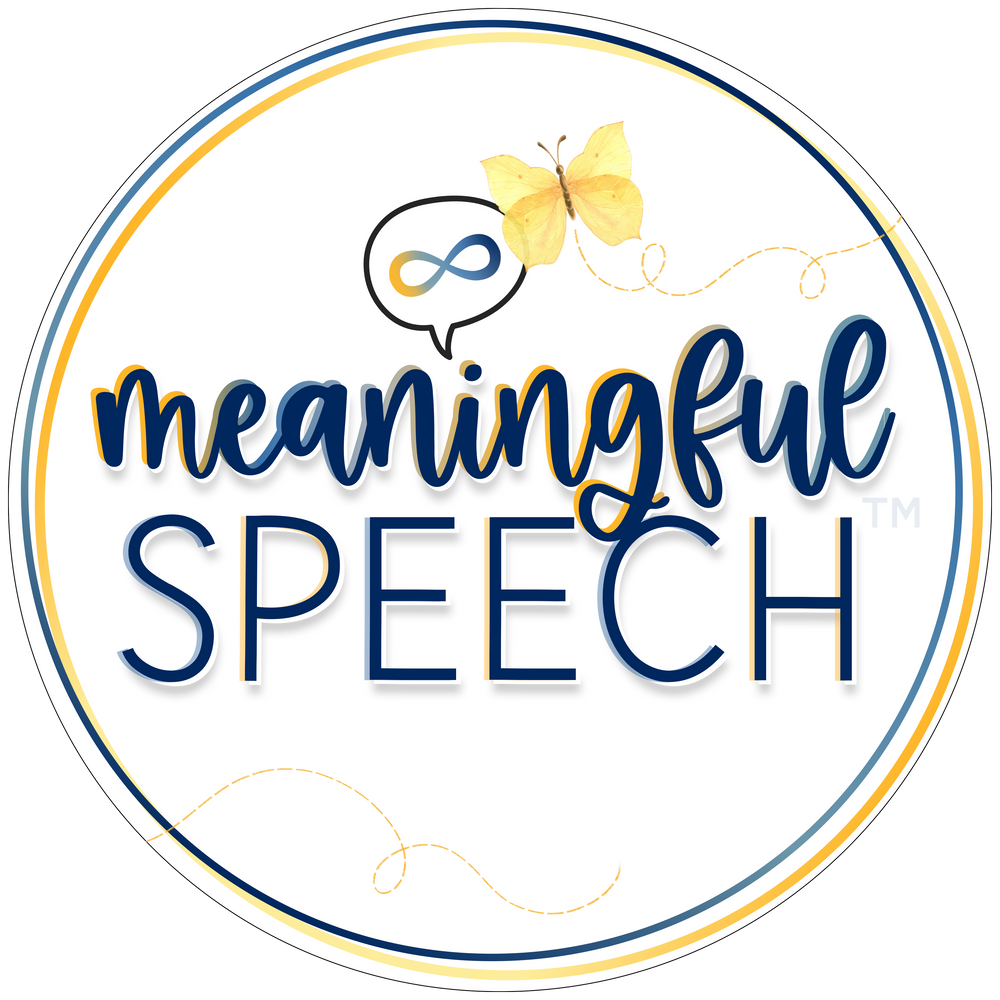Signs a Gestalt Language Processor is Self-generating language
Sep 25, 2024
We talk a lot about the early stages of gestalt language development, so you might be wondering how you’ll know if/when a child is using self-generated language? There are some signs you can look for that will help you determine if language is self-generated.
First, Let’s review the stages of Gestalt Language Development (Blanc, 2012).
Stage 1: Delayed Echolalia
Scripting whole gestalts, single word gestalts, and/or intonationally defined strings of language from people, media, songs or books.
Example: "There's a monster at the end of the book!"
Stage 2: Mix and Match Stage or “Trimming down” (Partial Gestalts)
Mitigating larger Stage 1 gestalts into smaller chunks and also mixing and matching parts/chunks of Stage 1 gestalts into semi-unique utterances.
Examples #1 (mixing of two partial gestalts): "There's a monster + under there" = There's a monster under there.
Example #2 (Trimming down): "There's a monster."
Stage 3: Single Words and Two-Word Combinations– This is the magic stage where gestalt language processors are starting to recognize single words as individual units of meaning. They’re beginning to self-generate single words and two-word noun combinations.
Breaking gestalts down to one word unit and/or making a new two-word noun combinations (noun + noun, noun + adjective, with no regard for word order).
Example: "monster", "scary monster", "monster red"
Stages 4-6: New Original Phrases or Sentences with Beginning Grammar, More Advanced and Complex Grammar – This is when gestalt language processors are when they’re beginning to use self-generated phrases and sentences starting with beginning grammar and moving on to more advanced and eventually complex sentences.
Putting word units together to make novel phrases or sentences. At Stage 4, children are using beginning grammar. At stages 5-6, children begin using advanced and complex grammar.
Examples: “The monster goed under” (Stage 4) “The monster can’t get out” (Stage 5), “Shouldn’t he have come out from under the bed by now?” (Stage 6).
So what are some signs to look for that indicate your gestalt language processor is in stage 4+?
- They are able to tell you where gestalts are from. Later stage gestalt language processors will still use gestalts at times for a variety of reasons (more about this below). As they progress into the later stages, they may start to tell you where the gestalt comes from. Check out this example of a clip from a therapy session HERE.
- Example:
- Child: I'm not a squirrel, I'm a young prince.
Therapist: Where's that from?
Child: Yea, we saw this movie. Bambi.
- Child: I'm not a squirrel, I'm a young prince.
- Example:
- They are beginning to easily answer wh-questions. Until Stage 4 (self-generated phrases/ sentences), a gestalt language processor does not have the flexibility in their expressive language to respond to wh-questions in a manner that would represent their understanding of language. Check out this example from a therapy session HERE.
- Example:
- Therapist: "Who was the story about?"
Child: "It about Paddington"
- Therapist: "Who was the story about?"
- Example:
- They are producing utterances with beginning grammar.
- Examples:
- "No, she don't"
- "She have his boots"
- Examples:
- They are showing signs of disfluency, scripts are fluent but original language sounds disfluent. This means the "wheels are turning" and NOT that the child has a new problem- stuttering! They are reaching for their "freed" words to create a novel utterance! Check out this example from a therapy session HERE.
- Example:
- "Th th th that one over there"
- "Thhhhat game is fun!"
- Example:
- They are producing utterances that "don't make sense" to the unfamiliar listener (they are combining freed words to express an idea, it is self-generated).
- Example:
- "Now his boots on, so we don't have any shoes." (What the child meant: We are ready to go- boots are on and we don't need get on anything else!)
- Example:
- They have pauses between words and taking more time to generate what they want to say.
- Example:
- "I...got...it"
- Example:
You might see some or all of these signs when a gestalt language processor begins self-generating language. All of these are perfectly normal when children begin to communicate in stage 4 and they are not cause for concern! Listening and taking language samples is the best way to figure out what stage a child is mainly in. The stages are not linear and gestalt language processors often communicate using a mix of stages. It is important that we take many spontaneous language samples and score those using the Natural Language Acquisition (NLA) framework to determine which stage the child is using most. We will then support them based on the stage they’re mainly in.
How do we support a child when they’re mainly in Stages 4+?
Stage 4 is when we begin to support grammar. Up until this point (Stages 1-3), we’re not worried about grammar at all. We choose grammar targets based on the Developmental Sentence Types and Developmental Sentence Scoring by Laura Lee. Therapy looks the same in these stages as it did in the earlier stages. We’re not correcting the child’s grammar directly. We’re modeling grammar targets naturally. We’re still using child-led therapy. Stages 4+ is when we can begin to support “other” goals outside of NLA goals. For example, we may begin to target storytelling/narratives, problem solving and asking and answering WH questions. We may also support neurodiversity-affirming social communication goals, we’re provided some examples of areas you may focus on for social communication HERE. We have numerous video examples of supporting later stage gestalt language processors on our Instagram.
Gestalt language processors will always be gestalt language processors
What do we mean by this? Even when gestalt language processors are mainly in Stages 4+ and self-generating language, they will still pick up and use gestalts. Gestalt language processors will always be gestalt language processors. This doesn’t change when they’re mainly in Stages 4+. Many adult gestalt language processors have shared that they pick up gestalts and use them when they can’t access their original, flexible language. This might happen due to moments of dysregulation or heightened emotions. They also use gestalts for vocal play, stimming and because communicating with gestalts might bring them joy!
Want to learn more in-depth information about how to support gestalt language processors?
-
There are many free podcasts, webinars and articles to get you started. A comprehensive list of resources can also be found on our website. We just released a new FREE masterclass on echolalia and child-led therapy that is perfect for anyone starting their learning journey or on the fence about purchasing our courses!
-
Consider taking the Meaningful Speech course to learn more about how your child or client processes language, how you can help support them from echolalia to self-generated (original flexible) language, child-led therapy, and neurodiversity-affirming practices. Looking for something shorter? We have a 1-hour introductory course perfect for extended family, daycare or school staff.
-
Consider taking our AAC + Gestalt Language Processing course. It will teach you how to identify, evaluate and support gestalt language processors who use AAC or who you think might benefit from AAC.
-
Look for a speech-language pathologist (SLP) who "gets it" and can help you in supporting your child's language development. Check out our registry for SLPs who understand gestalt language processing and child-led therapy.
-
Are you a school-based or private practice clinician looking for intake forms for new clients/students or creative visual reminder posters for your space? Check out the Meaningful Speech Marketplace.
-
Want to learn more about starting a niche private practice? Watch our 1-hour webinar on starting a niche private practice hosted by Alex Zachos and Jess Teixeira from the Meaningful Speech team HERE.
